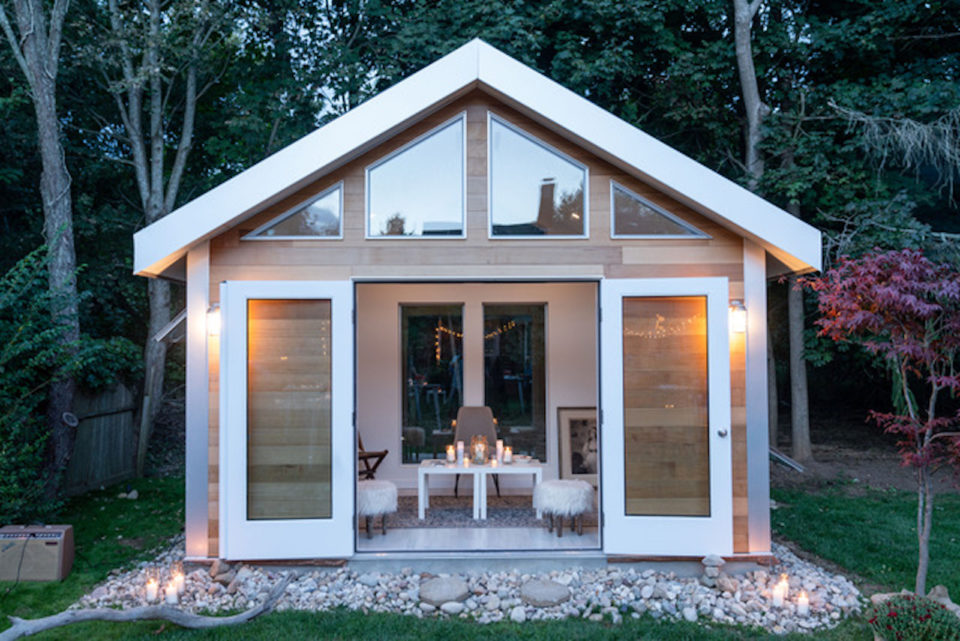Garden rooms and backyard studios aren’t a trend—they’re a thoughtful response to how people want to live now. These aren’t sheds. They’re insulated, connected, beautiful little buildings that live in the garden but think like proper rooms. Whether it’s a modern glass cube or a rustic timber cabin, the rise of these structures signals a deeper shift in how we define personal space.
In the past, a backyard structure meant a place to store rakes and bicycles. At best, it might be a summerhouse with a couple of lawn chairs. But then came the scramble for space. Families found themselves working from kitchen tables, teaching kids algebra in the living room, and craving some kind of physical boundary between roles. Garden rooms answered that call.
By 2021, suppliers of prefab studios were reporting record backlogs. Google searches for “garden office” and “backyard studio” skyrocketed. And homeowners, faced with the cost of moving or building an addition, began to look at their outdoor square footage in a new light. These structures promised freedom: a quiet space without construction dust inside the house.
But they’re not just for work. Artists set up painting spaces that smell faintly of turpentine and pine. Musicians plug in amps without worrying about waking the baby. Guests settle in without needing to tiptoe around the main house. Some people even use them for therapy sessions, meditation, or part-time rental income.
They aren’t just buildings—they’re enablers of privacy, creativity, and calm.
If you’ve ever looked at your garden and thought, “I could use that space better,” you’re not alone. This guide will help you understand the landscape—what garden rooms really offer, how to plan and build smartly, and how to make them feel like a true extension of your home.
Planning and Purpose – Choosing the Right Use Case
Let’s start with the most important question: why do you want this space?
Be honest with yourself. Are you trying to escape the kitchen noise while on Zoom calls? Do you need space to spread out canvases, rehearse monologues, or run yoga classes? Or are you thinking about extra sleeping space for when friends visit—or even about earning some rental income on the side?
When you define the primary use clearly, the rest falls into place. A quiet writing studio won’t need plumbing. A guest room probably should. A remote office might need hardwired internet. A photography studio might require blackout blinds and soundproofing. Let your needs drive your plan.
Next comes the not-so-fun stuff: zoning and permissions. This part’s tempting to skip, but don’t. Every city, council, and county has its own rules. Some allow you to build a structure up to a certain size without a permit. Others are strict about height limits, how close you build to the fence, or whether your structure can include a toilet.
Call or email your local planning office. Have your property dimensions and proposed size ready. Ask about:
- Maximum allowed square footage
- Setback requirements
- Plumbing and electrical rules
- Rental or habitation limitations
This conversation could save you serious time and money.
Once you know what’s allowed, think about where to put it. Morning light? Afternoon shade? Noise from the road or neighboring properties? Consider:
- Sunlight direction (good for plants or energy efficiency)
- How far it is from the house
- Is there room for a path?
- Privacy from both your home and the neighbors
And then, utilities. Power can often be extended from the main house—though trenching a conduit is no small task. Internet can sometimes piggyback off Wi-Fi, but a hardline is best for offices. Plumbing opens a whole different door: drains, frost protection, even hot water tanks.
A useful checklist:
- Define your top priority for the space
- Check with your city/council about legal limits
- Walk your garden to see the best spot for light, noise, and access
- Make a list of must-have utilities
- Sketch your dream layout, then reality-check it with the rules
This phase can feel like a tangle of questions. But clarity now makes for a smoother build—and a better space.
Construction Options – From DIY to High-End Modular
So, how do you get your garden room from sketchpad to real life?
DIY Builds If you’ve got the time, tools, and tenacity, a DIY build is the cheapest way to go. You can create a structure exactly to your taste, often at a fraction of the cost. But it’s not a weekend job. You’ll need:
- Basic carpentry skills
- Tools like a circular saw, drill, level, and nail gun
- A plan for foundations, insulation, cladding, and roofing
Pros:
- Budget-friendly
- Total design control
Cons:
- Time-consuming
- Errors can cost more later
- Inspections might be needed even for DIY
Prefab Studios Prefab units are incredibly popular—and for good reason. Companies like Studio Shed, Modern Shed, and even IKEA (yes, really) offer sleek, modular buildings that arrive flat-packed and can be assembled quickly.
Some come fully finished, others as shells. Most offer customization: window placement, wood finishes, rooflines. They often look fantastic and come with warranties.
Pros:
- Fast setup
- Predictable quality
- Easier to pass inspections
Cons:
- Can be pricey, especially with add-ons
- Less room for improvisation
Hiring a Contractor Want a seamless, stress-free build? Bring in a pro. Contractors can help you navigate permits, adjust for sloped yards, and handle utilities.
Interview at least two or three builders. Ask to see similar projects. Check licenses. Ask about timeline and budget milestones.
Pros:
- Expert advice and execution
- Custom-built to match your home
Cons:
- Most expensive route
- Less hands-on involvement
Don’t skip the insulation and waterproofing. A poorly sealed studio will turn into a sweatbox or icebox. Invest in:
- Double-glazed windows
- A raised, insulated floor
- Roof overhangs or rain protection
- Ventilation options like trickle vents or ceiling fans
This is where your garden room turns from a box into a real room. Treat it with the care you’d give any indoor space.
Designing the Interior – Function, Comfort, and Second-Hand Finds
Now the fun begins. Interior design for garden rooms is all about function first—and beauty right after.
If you’re working from this space, start with your desk. Ideally near a window, away from the door, with enough room for movement. Lighting matters. Natural light is gold, but once the sun goes down, you’ll want soft overhead lights, a task lamp, and maybe a warm accent light for evenings.
Thinking of turning it into a guest suite? Use a Murphy bed or daybed with built-in drawers. Add blackout curtains and a tiny bedside table. For yoga or meditation, keep the floor open, add a mat, maybe a wall mirror, and use calming tones.
Climate control matters more than you think. Even in temperate climates, it’s smart to prepare for both cold snaps and heat waves. Electric panel heaters are affordable and easy to install. Mini-split systems are pricier but excellent for year-round comfort.
Storage can be your best friend or worst enemy. Choose:
- Floating shelves
- Storage ottomans
- Fold-out desks
- Pegboard walls
Then there’s furniture. And this is where second-hand can shine. You don’t need a showroom look—you need function and soul.
Why buy second-hand?
- It’s more affordable
- It’s sustainable
- It often has more personality
What works well used?
- Lamps
- Rugs
- Desks
- Cabinets
One reader found a weathered restaurant furniture bench at a closing café. Now it sits under her studio window, holding throw pillows and memories.
Second-hand doesn’t mean scruffy. It means layered. A new structure deserves pieces with stories.
Multi-Purpose Use and Rental Income Potential
Your garden room can do more than serve you—it can earn for you.
Platforms like Airbnb now feature entire categories for tiny studios, garden cabins, and backyard guesthouses. In popular cities or travel-heavy towns, your little retreat could be booked out every weekend.
But it’s not just about tourists. Some people rent their studios to remote workers who need peace, or musicians who want to record without interruption.
To go this route, you’ll need to:
- Check if rentals are allowed in your area
- Add basic safety features (smoke alarm, lockable entry)
- Make sure there’s separate access if required by local law
From a numbers angle, many owners report covering their entire build cost within two to four years of light rentals.
Some even split usage: they work in the space on weekdays and rent it out on weekends. A quiet Airbnb guest rarely disturbs Monday Zoom meetings.
Rethinking Square Footage and Personal Space
The real gift of a garden studio isn’t just extra square footage—it’s better square footage.
When you create space with intention, it changes how you use it. The act of stepping outside, even a few steps, shifts your brain. Work feels separate. Rest feels deeper. Creativity flows with fewer distractions.
In a world that often feels crowded, noisy, and rushed, a quiet room in the garden is a luxury—but one that’s increasingly accessible.
Plan wisely. Build thoughtfully. And furnish it with care—especially with second-hand items that add story and warmth. That old bench you almost passed up might become the one thing everyone compliments.
And that’s the beauty of these spaces. They aren’t just an extension of the house. They’re an extension of you.




